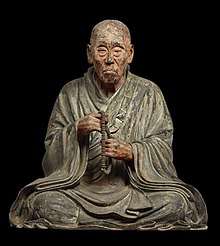Chōgen (monk)
[1] Chōgen (重源) (1121-1206), also known as Shunjōbō Chōgen (俊乗坊重源), was a Japanese Buddhist monk. From 1181 he devoted twenty-five years of his life to the endowment and rebuilding of Tōdai-ji after its destruction in war.
Chōgen | |
|---|---|
 Portrait of Chōgen, enshrined in the Shunjodo at Tōdai-ji | |
| Title | Tōdai-ji reconstruction great Kanjin, Dai-Osho(great monk) |
| Other names | Shunjobo |
| Personal | |
| Born | Kino Shigesada 1121 |
| Died | 1206 Nara, Tōdai-ji |
| Religion | Buddhism |
| Nationality | Japanese |
| Other names | Shunjobo |
| Occupation | Responsible person for the reconstruction of Buddha statue at Todaiji |
| Senior posting | |
| Based in | Tōdai-ji, Nara |
| Successor | Myonan Eisai as Dai-Kanjin |
Sources
.jpg)
A contemporary record known as the Benevolent Deeds of Namu-Amidabutsu provides the fullest evidence for Chōgen's life and career.[2][3][4] This may be supplemented by diaries such as the Jewelled Leaves (玉葉) of Fujiwara no Kanezane; temple records; documents including Solicitation for Funds by Chōgen in Genkyū 2; and inscriptions including one on stone dating to 1202 from Kawachi Province recording his repair of irrigation channels first constructed by Gyōki Bosatsu.[2][5][6] By the time of the illustrated Tōdaiji Daibutsu engi of the 1530s, which includes a scene of Chōgen at sea conveying logs for the great rebuilding, invocation of his memory could include a "mixture of fact and fable".[7]
Biography
Born most likely in Kyoto in 1121, Chōgen was initiated into religious life at the Shingon centre of Daigo-ji at age thirteen. Later in his teens he undertook ascetic practices in Shikoku and at Mount Ōmine, followed in his early twenties by time at Koyasan. After assorted pious deeds, including chanting the nembutsu a million times and the donation of statues and sutras to a number of temples, involvement in public works in the manner of Gyōki and Kūya, and possible trips to China, in 1181 Chōgen was appointed to raise funds for the reconstruction of Tōdai-ji. Over the next twenty-five years he oversaw repairs to the Giant Buddha, the hall in which it was housed, the south gate, and numerous other buildings in the temple complex, as well as being involved in the commissioning of numerous replacement images. He also continued his civic works, repairing bridges, driving robbers from the mountains, and easing the distress of man and beast. He finally died in the Pure Land hall at Tōdai-ji at the age of eighty-five in 1206.[2][7]
See also
References
- "木造俊乗上人坐像(俊乗堂安置)" [Seated wooden statue of Shunjō shōnin (enshrined at the Shunjōdō)] (in Japanese). Agency for Cultural Affairs. Retrieved 26 April 2012.
- Rosenfield, John M. (2011). Portraits of Chōgen: The Transformation of Buddhist Art in Early Medieval Japan. Brill. pp. 207–31. ISBN 9789004168640.
- "南無阿弥陀仏作善集" [Namu-Amidabutsu Sazenshū (Benevolent Deeds of Namu-Amidabutsu)] (in Japanese). Agency for Cultural Affairs. Retrieved 26 April 2012.
- "貴重書" [Rare Documents]. Historiographical Institute, the University of Tokyo. Retrieved 26 April 2012.
- Kobayashi Takeshi (1965). Shunjōbō Chōgen shiryō shūsei [Compilation of Historical Records relating to Shunjōbō Chōgen] (in Japanese). Nara Kokuritsu Bunkazai Kenkyūjo.
- "元久二年重源上人勧進状" [Solicitation for Funds by Chōgen in Genkyū 2] (in Japanese). Agency for Cultural Affairs. Retrieved 26 April 2012.
- Rosenfield, John M. (2011). Portraits of Chōgen: The Transformation of Buddhist Art in Early Medieval Japan. Brill. pp. 25–43. ISBN 9789004168640.